Sally FitzGerald celebrates the 100th anniversary of DH Lawrence’s move to Lake Garda with a tour around the town of Gargnano…
When someone visits a place for a day and decides to stay for six months you know they must have discovered something quite special. This is exactly what happened when the much-loved English writer DH Lawrence stumbled upon the picturesque town of Gargnano on the shores of Lake Garda exactly 100 years ago.
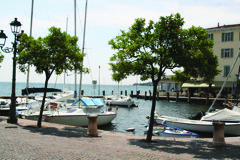 It was 1912 and DH Lawrence was having an affair with Frieda von Richthofen, the wife of a university professor. Wanting to escape both Frieda’s husband and the turmoil of the Industrial Revolution which was in full swing in England, the pair decided to set off on their travels to discover new people, cultures and a more relaxing lifestyle. Their first destination was Frieda’s home country of Germany, but soon they wanted to travel further south, so set off on a long trek over the Dolomites.
It was 1912 and DH Lawrence was having an affair with Frieda von Richthofen, the wife of a university professor. Wanting to escape both Frieda’s husband and the turmoil of the Industrial Revolution which was in full swing in England, the pair decided to set off on their travels to discover new people, cultures and a more relaxing lifestyle. Their first destination was Frieda’s home country of Germany, but soon they wanted to travel further south, so set off on a long trek over the Dolomites.
By September 1912 they reached the northern end of Italy’s Lake Garda and the town of Riva del Garda. Like so many other authors, Lawrence fell in love with the lake and the endless inspiration it could provide a creative mind, but Riva proved too expensive for them to set up a permanent residence. One day they decided to go on a boat trip to the smaller town of Gargnano on the western side of the lake, and heard by chance about a flat that was available to rent within their budget. It became their home from 18 September 1912 until 30 March 1913.
Even though 100 years have passed since Lawrence and Frieda arrived in Gargnano, little has changed in the town. apart from a few essential roads now winding their way through the centre and more houses popping up to expand the town’s boundaries. Gargnano has essentially escaped the tourist trappings of many of the lake’s most popular locations and so it is still possible to walk around the area and follow in Lawrence’s footsteps to recreate a few of his experiences. Here are some of the main landmarks left to discover.
Villa Igea
Lawrence and Frieda’s Lake Garda flat was located on the second floor of a large yellow-painted building called Villa Igea, which now wears a white 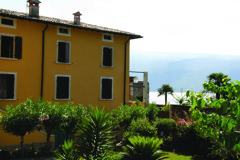 plaque revealing its most famous resident. Situated in Villa (meaning rural settlement), a small village on the outskirts of Gargnano, the rent was cheap but the flat still benefited from stunning views of the lake. Lawrence often commented on how he would lie in bed of a morning and watch the sunrise over the mountains, eventually filling the room with light. To him, this was paradise.
plaque revealing its most famous resident. Situated in Villa (meaning rural settlement), a small village on the outskirts of Gargnano, the rent was cheap but the flat still benefited from stunning views of the lake. Lawrence often commented on how he would lie in bed of a morning and watch the sunrise over the mountains, eventually filling the room with light. To him, this was paradise.
The sunshine and climate were actually the main motivations for Lawrence and Frieda to stay on Lake Garda. Lawrence was suffering from tuberculosis and the sun was thought to offer a vital source of energy to help battle the disease. But it provided him with inspiration too, and far from being a holiday or time for convalescence, Lawrence wrote many of his best works while staying in Villa Igea. He finished Sons and Lovers, started work on The Lost Girl which would later be called The Rainbow and The Sisters which became Women In Love, plus penned his first travel book Twilight In Italy.
It is in Twilight In Italy that we discover most about Lawrence’s time on Lake Garda, as he takes us with him on his day-to-day encounters with the locals and explores his surroundings. One such encounter involved visiting his landlord, who he refers to as the padrone. The padrone lived in a grand house called Villa De Paoli set just behind Lawrence’s flat. It has now been transformed into offices and a car park, but next to the building you will find a garden shaded by beautiful olive trees and featuring a pergola under which Lawrence liked to sit and watch the daily comings and goings of the boats on the lake.
The Lemon Houses
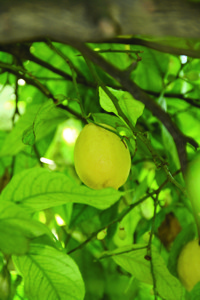 It was in the grounds of Villa De Paoli that Lawrence had his first experience of Lake Garda’s iconic lemon houses. Unlike anything he had ever seen before, in Twilight in Italy he described them as looking like “naked pillars, rising out of the green foliage like ruins of temples”. While the fruit was growing and the sun shining on the leaves Lawrence thought the houses were beautiful, but as soon as winter arrived he regarded them as sordid and ugly because of the big wooden shutters that were put up to protect the trees from the inclement weather.
It was in the grounds of Villa De Paoli that Lawrence had his first experience of Lake Garda’s iconic lemon houses. Unlike anything he had ever seen before, in Twilight in Italy he described them as looking like “naked pillars, rising out of the green foliage like ruins of temples”. While the fruit was growing and the sun shining on the leaves Lawrence thought the houses were beautiful, but as soon as winter arrived he regarded them as sordid and ugly because of the big wooden shutters that were put up to protect the trees from the inclement weather.
Before he knew the purpose of the “wooden greenhouses” he was confused by the sight of men climbing up ladders and leaping from one small ledge to the next, in order to lay the large wooden panels across the pillars and hammering loudly as they did so. Having just left behind an industrial England, it was also odd for him to see everything being done by hand. Despite hating the machines, Lawrence saw the Italian way of doing things as backwards, as if they were living in the past.
Today the only sign of Villa De Paoli’s lemon house is the presence of a few pillars hidden behind the car park. A sad reminder of a once majestic past. As you walk along the main road from Villa to Gargnano you will however come across La Molora, a private lemon house that the owner is working hard to restore to its prime. Here you can see for yourself the imposing pillars and lemon trees working their way up the hill, in the way that Lawrence was so intrigued and perplexed by.
San Tommaso
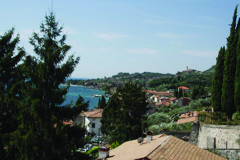 From his flat, Lawrence could see a church set on a slight hill overlooking the village, that he often glanced at but never thought to visit. One day when he heard the gentle ringing of the church bells he decided to try and find out more about it. There was no obvious path to the church, so Lawrence went out the back door of his house and made his way through the narrow side streets, unsure of quite where he was going.
From his flat, Lawrence could see a church set on a slight hill overlooking the village, that he often glanced at but never thought to visit. One day when he heard the gentle ringing of the church bells he decided to try and find out more about it. There was no obvious path to the church, so Lawrence went out the back door of his house and made his way through the narrow side streets, unsure of quite where he was going.
It was while walking these side streets of Villa that Lawrence felt the most alien and alone during his time on Lake Garda. In Twilight in Italy, he describes how odd it was walking through the narrow passageways, which were dark and shady compared to the brightly-lit paths by the lakeside. He could see the town’s inhabitants staring at him suspiciously through their windows, wondering who this stranger was. Gargnano wasn’t often visited by tourists and so Lawrence felt that his pale skin shone out even more here, and feared that it turned him into something of a spectacle.
After several unsuccessful attempts to reach the church, Lawrence eventually discovered a long broken stairway that led him to the courtyard of San Tommaso, or the church of the eagle as he called it, which still provides access to the building today. When you reach the summit you will be greeted by a similar sight to Lawrence; countless red-slated roofs spread out beneath you, giving way to the seemingly never-ending water of the lake. It’s hardly surprising that Lawrence described this platform as “suspended above the village, like the lowest step of heaven or Jacob’s ladder, the terrace of San Tommaso is let down from heaven and does not touch the earth”. Everywhere Lawrence went in Villa and Gargnano seemed to provide him with the new experiences and inspiration he had been searching for when he first embarked on his travels, and San Tommaso certainly found a special place in his heart.
As you wander the streets of Villa and Gargnano, stopping briefly at the pretty little harbour where Lawrence first arrived in the town and passing by the theatre which remains as it would have looked to Lawrence on the outside, you can see why he chose to stay here so long.
Italy and Lake Garda have become such familiar destinations for us today, but for Lawrence, there was still so much to explore and understand, so much that was alien and intimidating and yet at the same time captivating and exciting.
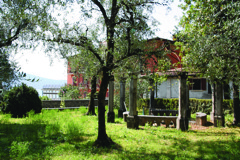 He couldn’t help but be drawn to the unique character of the town, the intriguing local people and the beauty of the lake itself. Of course, it is an area which has inspired so many minds over the years.
He couldn’t help but be drawn to the unique character of the town, the intriguing local people and the beauty of the lake itself. Of course, it is an area which has inspired so many minds over the years.
As Gargnano celebrates the 100-year anniversary of an English stranger choosing the town as his home, and in doing so instilling it with a little glimmer of fame, it’s the perfect time for us to visit Gargnano and see for ourselves exactly what inspired Lawrence to write some of his best works here.
If you’d like to find out more about Lawrence’s time on Lake Garda, or learn how you can visit Lawrence’s favourite spots in Gargnano, simply visit www.dhlawrence.eu/en
